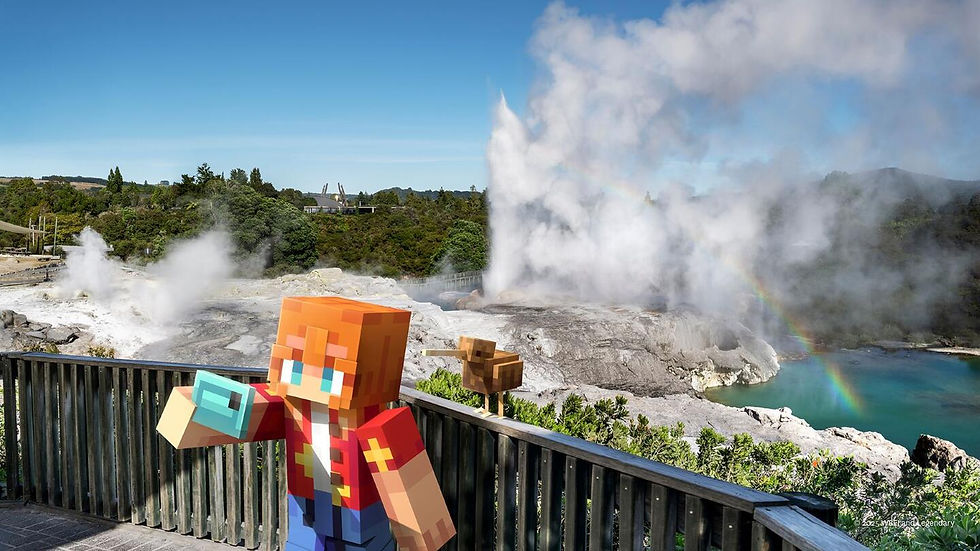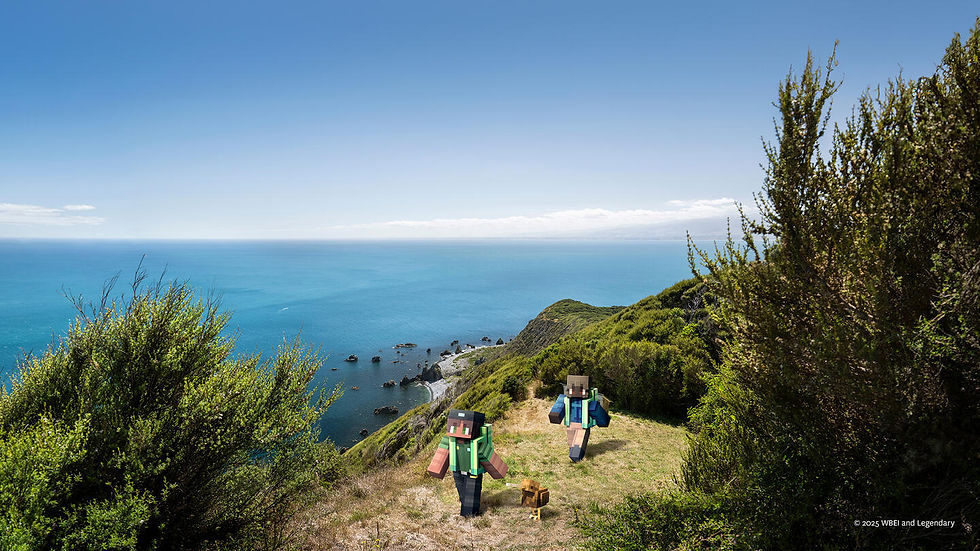How Minecraft turned New Zealand into Pixels. And Did so Respectfully.
- India Gustin
- May 30
- 6 min read
Drifting down the waterway, the rocks begin to glow a saturated blue, a surreal moment as you realise you finally made it to the Waitomo Glowworm Caves, one of New Zealand’s most breathtaking natural wonders. You look around, stunned that you finally get to experience more of what the country has to offer. Except you aren't actually there. Not really. It’s all happening behind a computer screen. This is Aotearoa New Zealand, a culturally rich, reimagined world built inside the best-selling game of all time: Minecraft.
So what does it take to turn a video game into a vessel for cultural preservation? For the team behind the whole project, the answer was months of dialogue, tribal meetings, and a refusal to cut corners. Launched alongside A Minecraft Movie, this ambitious collaboration between Mojang Studios, Warner Bros, Tourism New Zealand, and Māori leaders set out to do more than build a digital replica of one of the most culturally-rich countries out there.

It’s only been a couple of month since Warner Bros released A Minecraft Movie, featuring the all-mighty Jack Black and a noob-inspired Jason Mamoa. As part of their promotional stunt, Minecraft partnered with Tourism New Zealand to create Aotearoa New Zealand, an entire Minecraft world for players to explore the country’s culture and heritage (and ridiculous landscapes).
Yet the hardest part wasn’t developing it from a software point of view, it was doing it in way that respected such a profound and complex culture. From having year-long discussions with Māori representatives and tribes to implementing culturally significant activities as authentically as possible, the whole project was about a lot more than just copying and pasting famous landmarks into a game.
Of course, the entire project involved many, many people and agencies including Tourism New Zealand, 11 mana whenua groups, the tourism industry, Warner Bros, and Mojang Studios (the developers of Minecraft). The end result meant having New Zealand as the first fully playable destination in a Minecraft world.

Piki Studios is an official Minecraft Partner and award-winning Māori game design studio who was responsible for officially building the Minecraft world. Chief Business Operator, Whetu Paitai, led the development whilst collaborating with Tourism New Zealand. Between having intense discussions with tribe leaders to being able to explore different regions across the country, Whetu recalls the significance of the entire project: "Since 2018, we’ve been able to work with Mojang in a way that looks at crafting policies that allow for successfully telling indigenous stories and making sure that indigenous stories are being told by indigenous voices."
Traditional Minecraft worlds include having free rein over the game, with no plot or storyline to follow. Aotearoa New Zealand however, incorporates some significant cultural elements which the player can take part in. “I’m really excited about the Wharenui in the game, the first Wharenui in Minecraft,” says Whetu. This is a traditional meeting house of the Māori and as the game’s first stop, the player is even welcomed by a mihi whakatau (a tradition Māori welcome ceremony).
The game features other culturally significant activities such as paddling a waka in Abel Tasman, stargazing in Takapō, exploring the Waitomo Caves, and discovering the wildlife in Kāpiti Island (yes, this means new animals). Developing each of these required a lot of collaboration with the communities in the area to represent the landmarks as authentically as possible.

John Barrett is is the managing director and founder of Kapiti Island Nature Tours and Nature Lodge. “We’ve been on the island since 1820. We are people of this place,” he says. Back in the late 90s, John and his family started the family tour business based on Māori principles. Even with such a rich heritage that goes back centuries, John admits it is a continuous learning curve trying to blend traditional values with such a dynamic and commercial environment. So when the game developers reached out about featuring Kapiti Island, there was a lot to think about.
“They were aware with our relationship with the department of conservation, and our relationship with our tribe,” says John. In New Zealand, tribes have relationships with particular geographical areas, one of them being Kapiti Island. Therefore, the decision-making process involved a lot more people than just John and his family.

“Those discussions were long, deep and meaningful,” recounts John. “[The developers] made it really clear from the outset that they would only be proceeding if they could be satisfied that there was full support from our tribal group.” In fact, from the get-go Mojang, Warner Bros and the Minecraft team were in this for the long run. They understood the importance of establishing a relationship built on a foundation of respect and understanding rather than jumping in feet first.
One of the game developer teams contacted John 18 months before the launch. The tribe meetings were spread out between 8 of those months. “We had four really deep and meaningful meetings with the game writers and Tourism New Zealand on the island, and they were very humble and thorough in terms of their demonstration of good will.
“We considered the opportunity for as long as we possibly could,” he continues. “We were nervous. No, that’s not the right word. We were wary rather than nervous. We were wary at the potential of something being portrayed in a less than good light.”
Understandably, one of the biggest risks which many communities spoke about was the potential of a huge company misrepresenting New Zealand culture and what that would mean to the entire country. “One of the biggest challenges was ensuring that the rich Whāraki - interconnected tapestry of stories, traditions, and cultural heritage - of our land and people was accurately and respectfully represented,” says Whetu.

He explains that one of the processes they undertook to ensure culture sensitivity throughout the development was through a “collaboration over consultation” approach. Additionally, they worked via the Wānanga Concept, an idea that “involves ongoing, open discourse that can span 2-3 nights, occurring during meals, hui (meetings), and breaks. This continuous process with our partners ensures that there is no such thing as ‘too late’ for input.”
As much as in-person respect was crucial to developing Aotearoa New Zealand, the in-game experience had to stay true to Māori heritage just as much. Above representing some of the country’s experiences as authentically as possible, so was adding other details such as artwork and even wood carvings into the map.
“In the game we have some really rich Mahi Toi (artistic work),” Whetu says, describing the individual artists behind some of the works portrayed in the game. The wharenui (meeting house), for example, was conceptualised by Clive Fugill, a master carver from Te Puia. Various other Māori artworks, deities, and even traditional musical instruments sounds are all featured on the map. “The whole identity landscape that includes Te Ao Māori is represented by content created by Māori people themselves.”
Many parties involved stood to benefit from the start (as long as respect and authentic representation were kept as promised). Between promoting A Minecraft Movie to an extreme spike in game-play for Mojang, tourism in New Zealand was of course a major consideration.
With over 300 million copies sold, Minecraft is the best-selling video game of all time. On top of that, it engages a humble 70% of New Zealand’s target audience in key tourism markets. Whilst it may be too soon to tell with specific statistics, these numbers already showcase this partnerships potential for the country’s tourism landscape.

As part of Tourism New Zealand’s four-year strategy and its New Zealand Screen Production Rebate, the board also collaborated with Flight Centre to curate Minecraft-inspired itineraries that provide a wholesome family experience. Between sitting down as a family to watch A Minecraft Movie, spending some downtime in Aotearoa New Zealand, and then flying out to experience it all in real-life, the whole affair is by definition, an extremely well-rounded travel experience.
The Aotearoa New Zealand Minecraft world is more than a marketing tie-in. It is a rare example of global entertainment platforms collaborating meaningfully with Indigenous communities. “It’s unusual. I’ve been in the business for quite a long time and its the first project of this type that I’ve come across with this degree of consultation,” John admits.
With careful attention to cultural integrity, deep-rooted Māori involvement, and genuine long-term commitment from developers, the project achieved what many branded efforts have failed to in the past: a respectful, educational, and engaging representation of a nation’s heritage. Whether the result is increased tourism, deeper understanding of Māori culture, or just one more reason to log into Minecraft, it proves that digital spaces can hold real-world significance, or at least when done right.



Comments